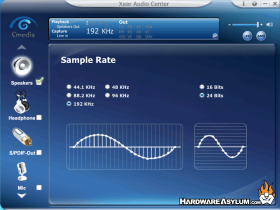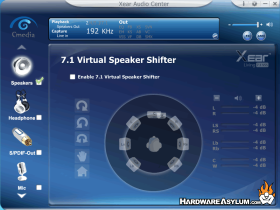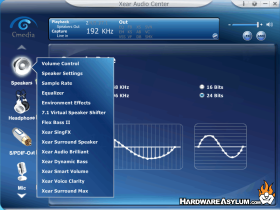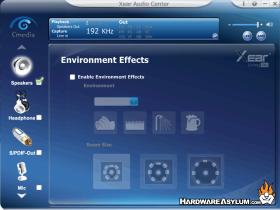Diamond Xtreme Sound 7.1 External Sound Card
Author: Warren YoungDrivers Testing and Conclusion
The drivers installed easily, and the menus were very intuitive and easy to move around in. Adjusting the sampling rates is as easy as pushing a few radio buttons in the Xear Audio Center controls, and selections are easily found in the dropdown menus in order to do a variety of things, including set up the surround sound, mark speaker placement and even add environmental effects.
In no time the sound card was set up to play at 24bit/192kHz for the test.
To measure the success of the Diamond Xtreme's sound, we chose the most obvious factor of any sound card, the audio quality. We set out to find if the sounds coming out of the Xtreme are richer and more dynamic than those produced from a typical onboard sound card.
For this test we are using the RightMark Audio Analyzer and a loopback cable to test audio reproduction. In both tests we set the drivers to the highest audio quality setting and for the test to be most accurate both the speaker output and line-in were set to their highest setting supported in the drivers.
Our challenge would both to see how well the Xtreme Sound 7.1 HD would perform, along with taking something that isn't known for fantastic audio quality, and seeing how much of a comparative improvement the Xtreme can offer. So, I present the challenger, my work laptop! Can the Xtreme Sound 7.1 HD turn this ordinary office workhorse into a surround sound powerhouse?
Let's find out!
ASUS K61IC Notebook with onboard stereo audio
Intel T4300 Dual-core 2.1 GHz processor
4GB DDR2-800 SDRAM
To keep the results as fair and comparable as possible, we tested the onboard audio and the Xtreme Sound 7.1 HD at the highest sound settings (24bit, 192kHz) available from the drivers.
Frequency response (from 40 Hz to 15 kHz), dB +0.29, -0.24 - Good
Noise level, dB (A) -68.9 - Average
Dynamic range, dB (A) 68.2 - Average
THD, % 0.019 - Good
THD + Noise, dB (A) -62.3 - Poor
IMD + Noise, % 0.113 - Average
Stereo crosstalk, dB -34.4 - Very poor
IMD at 10 kHz, % 0.111 - Average
General performance Average
Frequency response (from 40 Hz to 15 kHz), dB +0.06, -0.14 - Very good
Noise level, dB (A) -97.9 - Excellent
Dynamic range, dB (A) 97.8 - Excellent
THD, % 0.0019 - Excellent
THD + Noise, dB (A) -89.3 - Good
IMD + Noise, % 0.0099 - Very good
Stereo crosstalk, dB -92.2 - Excellent
IMD at 10 kHz, % 0.0039 - Excellent
General performance Very good
Looking at the results from the test, the Diamond Xtreme showed dramatic improvement over the sound quality offered by the onboard sound card. From the graph, total harmonic distortion recorded was just a tenth of what the onboard sound was registering, stereo crosstalk was reduced over 60 decibels comparatively, and the intermodulation distortion percentages saw significant improvement as well. In fact, there was not one measurement on the test that the Diamond Xtreme failed to outperform.
Depending on your motherboard, and the integrated sound chips, the difference you experience may not be as dramatic as our tests but, looking solely at the Xtreme Sound 7.1 HD's performance independently of the onboard sound it is producing quality sound without a lot of distortion and interference getting in the way.
Combining superior sound quality with the incredibly compact weight and space footprint you can definitely start to see the value in adding dedicated sound components to your portable devices. The only requirement is an external set of speakers which can include anything from regular headphones to a full surround home theater setup.
Analog, Digital and Optical outputs with 24Bit 196kHz sound
Optical input for HD recording
USB 2.0 compliant
Lightweight, Compact and Modern looking
7.1 full HD audio
Exterior analog controls only affect volume
Equalizer settings only accessible through system tuner controls in the UI





